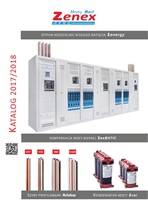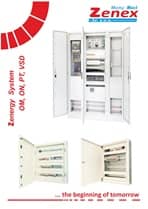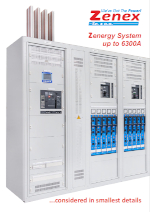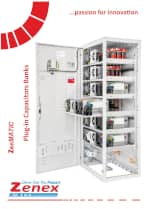
From the days when the low-voltage switchgear used simple, painted aluminum flat busbars nothing has changed, except that today dominate the flat copper busbars. People have seen many disadvantages in aluminum: too soft electrical conductor, cannot withstand high short-circuit currents, kneading of aluminum joints, that cause subsequent overheating. Oxidation, cracking, and low conductivity of electricity in relation to copper. Is that true?

Copper coupler 100x10 for a AlCubar 2500A profile
Zenex as a manufacturer of Zenergy switchgear system, aiming to continuously improve the quality and price competitiveness has developed a system AlCubar profiled rails, which we believe has ruled out all the disadvantages of earlier solutions, and used up the advantages of aluminum. Cuponal solution is not perfect – same as copper bar bending possibility is advantage, but causing trouble with the size and a small profit in price. Conclusion is that connecting apparatus like ACB or MCCB still need to be made by flat copper busbar, which is easy forming and has the smallest dimensions. There is no possibility to develop a copper profiles that would be convenient in connection but not extremely expensive, as well as cannot use pure aluminum posing problems with connection. That is why we focused on rigid anodized aluminum profiles, coated with copper. Dedicated exclusively on the straight sections of switchgear system internal busduct. The important thing was to develop a profile shape, that would be easily connectable between it, giving the possibility to mount in standard insulators, and connect without any complicated fasteners intermediary with flat copper bars. The biggest drawback of existing profiles so far is illusory profit - producers set market price around 30% cheaper than the price of a standard flat copper busbar. Unfortunately, these profiles are available in certain lengths, mostly two-meter, which when installed in the switchgear have a useless waste that absorbs theoretical profit. The only remaining ease of installation is that the profiles contain a groove providing the possibility to insert the screw in any place. However, the already known solutions are usually with only one T-shaped groove. For example, for a profile of rated current of 2500A it is very difficult to connect in one place two copper bars 80x10. Also there is the need to use special shaped copper connectors to connect neighboring fields. Such solution in fact is having so much drawbacks, that appears much more expensive than standard copper busbars solution.

Straight 50x10 copper connector for 1000A AlCubar profile

Two sides connection to AlCubar by copper rails 80x10
| Profil AlCubar | Cross section [mm2] | Cross section relative to Cu | Circuit [mm] | Circuit relative to Cu | The mass relative to Cu | Equivalent to copper bus bars |
|---|---|---|---|---|---|---|
| 630A | 360 | x1.20 | 210 | x2.62 | 36% | 30x10 |
| 1000A | 670 | x1.34 | 400 | x3.33 | 41% | 50x10 |
| 1600A | 1160 | x1,45 | 460 | x2.50 | 44% | 80x10 |
| 2500A | 2500 | x1.56 | 510 | x1.42 | 47% | 2x80x10 |

Bilateral connection of 2x80x10 mm busbars

AlCubar profiled busbars: Dimensions and references
Taking into consideration the costs of the entire system, including insulators, special screws to connect the profiles, and copper connectors, for 2500A switchgear rated current with AlCubar is:
- more than 50% lighter
- 40% cheaper material
Moreover, the system AlCubar significantly reduces installation time by eliminating laborious copper bar cutting and punching. Another advantage is the possibility of making additional connection of output circuit anywhere, anytime even at short maintenance breaks. In the case of copper bridges it is often very difficult, or it require removal of the busbars from switchgear for modification. The AlCubar system provides several fastening elements in the form of a hammer screws, T-slot nuts that can provide connection of the output circuits anywhere along the rail AlCubar without removing adjacent existing connections. Also there are used sets from single till quadruple screws for fast and reliable (reinforced) connection between AlCubar profiles, or for output circuits.








